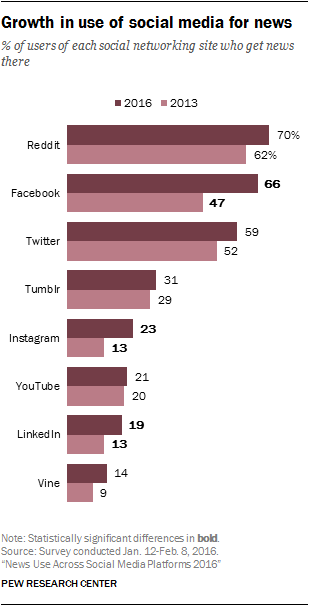Pew Research: 62 percent of US adults get news from social media
More than half of US adults are consuming news via social media, but there are missed opportunities and surprising statistics that show some interesting data across the various networks.
Pew Research Center has come out with its newest survey, reporting that 62 percent of US adults are getting their news on social media. After surveying 4,654 members of Pew’s American Trends Panel, it was found that 70 percent of reddit users access news from the social sharing network, 66 percent of Facebook users get news on the social network and 59 percent of Twitter users are finding the news on the microblogging platform. Trailing behind are Tumblr at 31 percent, Instagram at a surprising 23 percent, YouTube at 21 percent, LinkedIn at 19 percent, Snapchat at 17 percent and Vine at 14 percent.
As Pew notes, Twitter and YouTube are equivalent in their overall exposure. YouTube reaches about 48 percent of US adults, but only about 21 percent of users get news there. Twitter reaches 16 percent of US adults, but 59 percent of Twitter users are actually getting the news. This translates to an almost equal number of US adults.
In terms of general exposure, it appears that Facebook is where most of the news is being discovered, and news is typically being found on only one social network, with 64 percent reporting they find their news in a single location. Twenty-six percent of adults are using more than one social network to get their news; 10 percent get news on three or more sites.
What is most interesting, however, is how in 2013, when Pew last released a report on social media news consumption, Facebook, even with its controversial but highly visible Trending Topics, is not at the top; it’s in second place behind reddit, which many would argue is not really a news-breaking site. More important is the placement and popularity of YouTube for news. In the three years since the last survey data was released, there’s been little to no traction. This appears to reflect a missed opportunity on behalf of TV, cable and video media. Perhaps content isn’t being shared nearly as fast as it should. It could also be attributed to a poor design of the home page, which doesn’t lend itself to news discovery. Finally, perhaps YouTube is just falling behind the overall success of video news on other platforms, such as Facebook.
Opinions expressed in this article are those of the guest author and not necessarily MarTech. Staff authors are listed here.
Related stories

